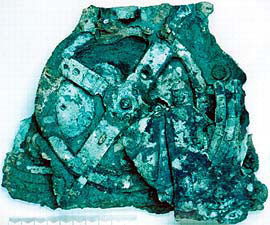
 |
The History of the Antikythera Mechanism  The Antikythera mechanism is perhaps the most perplexing piece of ancient machinery ever discovered. Its clockwork gears have puzzled researchers since its discovery in 1901, when a group of sponge divers off the isle of Antikythera found the ancient object. It is widely accepted that the Antikythera mechanism is of Greek origin and was used to calculate the movement of the stars and moon. In a sense, the Antikythera mechanism is the first analog computer known to man. Once recovered and cleaned, the Antikythera mechanism was seen for what it was – a complex system of gears compiled into a bronze device resembling a clock. It was recovered in three main parts along with much smaller fragments, all of which survived underwater for thousands of years. Though its origin is a mystery, scientific researchers have learned much from studying the device. In 1951, British science historian Derek J. de Solla Price began to systematically study the mechanical workings of the device. He concluded that the Antikythera mechanism was in fact an astrological device used to track the movement of the stars and planets. Price’s findings were first published in an article in Scientific American. Two decades later, in 1971, Price teamed with nuclear physics professor Charalampos Karakalos to complete a series of gamma and X-ray evaluations for analysis. His findings, which included a model, were once again published confirming how the device would have worked. In simplest terms, the Antikythera mechanism functioned through a series of differential gear arrangements that enabled the device to calculate the position of the stars, sun, moon, and other astrological information based on a future date the user entered. A reconstruction of the Antikythera mechanism constructed by Robert J. Deroski based on Price’s model is on display at the National Archaeological Museum in Athens. Another model is on display at the American Computer Museum in Bozeman, Montana. In recent years, Michael Wright, a Curator of Mechanical Engineering, compiled further data on the Antikythera mechanism that suggests the device may have been more complex than Price’s original analysis suggested. Wright constructed a working model, which indicates that the device may also have worked differently than originally believed. Currently, the Antikythera mechanism is being studied through a joint program between Cardiff University, the National Archaeological Museum in Athens, Hewlett Packard, and others, known as the Antikythera Mechanism Research Project. On October 21, 2005 it was announced that further fragments of the Antikythera mechanism had been discovered. There are now over 80 fragmented pieces of the device. During May of 2006, due to modern imaging abilities, researchers working on the Antikythera Mechanism Research Project announced that they could now read twice the Greek inscriptions included on the device than before. It continues to be a highly intriguing project for researchers, who may be able to learn more yet through the discovery of the newest fragments, which have been stabilized. The newest findings will be announced in Athens on December 1, 2006. |
What is the Antikythera Mechanism?  History of the Antikythera Mechanism
History of the Antikythera Mechanism News on the Antikythera Mechanism
News on the Antikythera Mechanism Experts on the Antikythera Mechanism
Experts on the Antikythera Mechanism
|
� 2006 Antikythera Mechanism |